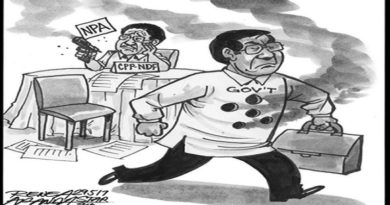Immigration: Visa retrogression strikes on Christmas By CRISPIN R. ARANDA
CRISPIN R. ARANDA
Next month’s US Visa Bulletin – announcing who are nearing the end of their immigrant visa waiting days – stopped visa interviews and left hundreds of thousands hanging until next year.
The US State Department announces the availability of visas to applicants in various categories, family-sponsored and employment-based, sometime during the second week of each month.
From September to November this year, the visa dates were moving forward almost for all family-sponsored categories except for the F1 (over 21 unmarried son and daughter of a US citizen) which was stuck at “01-Jan-07” for three months.
The F2B (over 21, unmarried son or daughter of a lawful permanent residents) moved by nine months over a one-year period; the F3 (married sons and daughters of US citizens) advanced by only 6 months; and the F4 (siblings of adult US citizens) moved by a year.
The dates opposite each category represents the date a visa petition was filed with the US Citizenship and Immigration Services (USCIS) for a qualified family member. A US citizen can file a petition for a spouse, parents and children – regardless of age or marital status.
A lawful permanent resident on the other hand (commonly known as a green card holder) may only file a petition for a spouse, and unmarried children regardless of age. However, the minor children (below 21) would still be considered eligible for the issuance of immigrant visas as the principal applicant (the qualified family member petitioned) as long as they are below 21 at the time visas become available.
Visas are available if the priority date (for the specific category) is already current, represented by “C”. An F1 visa applicant, for example, whose priority date for December 2017 is on or before January 1, 2005 should have his or her visa interview scheduled – if already documentarily qualified.
But the Grinch brought retrogression met by jeers instead of cheers.
The F1 category (over 21, unmarried sons and daughters of US citizens) priority dates moved back two years from last month. (See Final Action Dates chart, below.)
F2B visa applicants from the Philippines also would be set back one-and-a-half years.
Who got their stockings filled under the Christmas tree? The F2A (spouse and minor children of lawful permanent residents) whose priority dates moved forward a month and a week; the F4 by three weeks while the F3 inched just a week forward.
Date to start processing
The other chart, Date of Filing Application, is not a source of good news either for Christmas. The dates to start submitting documents to the National Visa Center to start processing did not move.
For RNs, getting a duly qualified US employer is no longer a “hit or miss” situation. There are hundreds—up to thousands—of approved job orders for qualified and eligible RNs in the EB3 and OW categories in the listing of licensed recruitment agencies with the Philippine Overseas Employment Administration (POEA).
Such an RN applicant must not only have passed the NCLEX examination but also must possess the VisaScreen Certificate from ICHP, a division of the CGFNS. That being completed, the waiting period from filing and visa approval is less than two years.
Charts explained
For the uninitiated, the two charts represent two scenarios: the Final Action Dates chart tells those in the immigrant visa waiting line that their priority dates are already current and ready for the final action, i.e., visa interview and visa issuance.
The other chart, Filing Dates for Family Applications, notifies applicants that they should start processing their visa applications, starting with appointing an agent, paying the visa fees, completing the immigrant visa application online, submit the other requirements so that by the time their priority dates have moved to the first chart, they would be considered “documentarily qualified,” meaning they have paid the correct fees and submitted all documents to establish eligibility for the specific visa category.
Over approximately the 5-year period, the F1 category moved forward 10 years; F2A – 6 years, 3 months; F2B – 5 years, 6 months; F3 – 2 years, 10 months; F4- 6 years.
However, from November to December 2017, all categories remained the same.
In a short span of five years, the EB 3 and Other Worker category for the Philippines have moved forward – fast. Likewise, these categories moved forward compared to four years and six months from the beginning of 2017. From 2012 (five years ago) the EB3 and OW categories moved 10 years or an average of two years per year.
Filipino nurses, other professionals, skilled and semi-skilled workers – even entry level Other Workers – have reason to welcome the holidays. And the New Year. The waiting period for visa interviews and issuance is now just over a year, compared to five to seven years in the immediate past.
For visa applicants affected by retrogression, rein in your expectations especially because of the current US administration’s avowed policy to restrict immigration.
For the others, hop on to Santa’s reindeers.
Courtesy: The Manila Times | By CRISPIN R. ARANDA on
.
NOTE : All photographs, news, editorials, opinions, information, data, others have been taken from the Internet ..aseanews.net | [email protected] |
For comments, Email to :
Icarus d’ Greek | [email protected] | – Contributor











